Pioneer DJ, also known as AlphaTheta, has surprised the DJ world with the release of the PLX-CRSS12, a turntable that has been years in the making and the subject of much speculation. This innovative deck immediately captured the attention of turntablists and hip-hop DJs, promising to bridge the gap between vinyl and digital DJing like never before.
The Pioneer PLX-CRSS12 boasts built-in DVS control, eliminating the need for needles or external accessories to play vinyl with digital control. This groundbreaking feature raises a critical question: Does this $1,400 turntable truly live up to the overwhelming hype?
Let’s delve into the details and explore the features of the Pioneer PLX-CRSS12.
Concept: A Modern Hybrid Turntable
 Close up of Gemini CD-T and Numark X2 turntables
Close up of Gemini CD-T and Numark X2 turntables
Gemini CD-T and Numark X2: Precursors to the PLX-CRSS12 hybrid concept.
The concept of a turntable with integrated digital audio control isn’t entirely new. Back in the late 2000s, companies like Gemini and Numark introduced hybrid devices that combined turntables with CD players. The Pioneer PLX-CRSS12 is a modern evolution of this concept, replacing CDs with DVS (Digital Vinyl System) technology for needleless control.
At its core, the PLX-CRSS12 modernizes the hybrid turntable by utilizing DVS instead of CDs, offering a unique method to manipulate digital signals. With a simple button press and the innovative Magvel Clamp, DJs can seamlessly switch between playing vinyl records and outputting a timecode signal generated internally by the turntable.
Beyond its hybrid functionality, the Pioneer PLX-CRSS12 is packed with features that make it a powerhouse turntable, including robust MIDI controls, a finely-tuned platter and motor, and creative tools like Step Pitch.
How the PLX-CRSS12 Delivers Needleless DVS Control
The PLX-CRSS12 employs a spindle locking mechanism, a technology familiar in the DJ world since the early 2000s. This concept is shared by devices like the Rane Twelves and One, and even earlier models like the Denon DN-S5000 from 2002. These systems use the turntable’s platter to control digital playback, offering a tactile vinyl feel with digital music libraries.
Pioneer DJ’s innovation lies in the Magvel Clamp, their unique solution for this locking mechanism. Unlike earlier systems that required adaptors bolted or screwed onto specific records, the Magvel Clamp offers a more versatile and user-friendly approach.
Introducing the Magvel Clamp: A Revolution in Vinyl Control
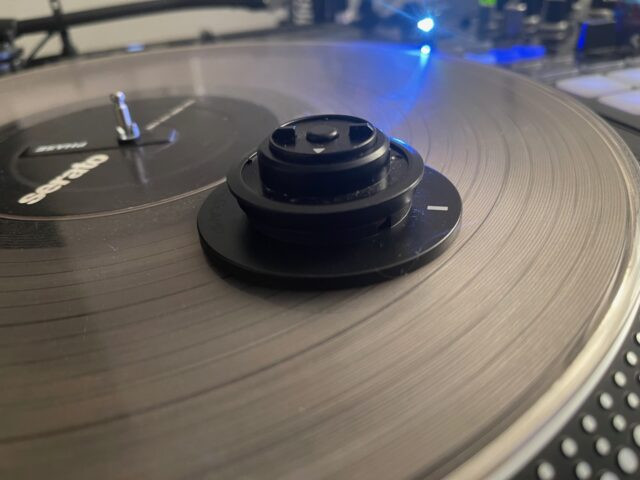 Close-up of the Magvel Clamp on the Pioneer PLX-CRSS12 turntable
Close-up of the Magvel Clamp on the Pioneer PLX-CRSS12 turntable
The Magvel Clamp: Pioneer DJ’s innovative solution for seamless vinyl and DVS control.
The Magvel Clamp, resembling a record weight, is the key to attaching any record to the spindle, enabling precise transport control within Serato or Rekordbox software. This ingenious design means DJs can use any vinyl record – or even just the slipmat – to control timecode signals. A standout feature is the adjustable tension of the Magvel Clamp, allowing DJs to customize the “slipperiness” of the record on the platter, catering to different scratching styles and preferences.
The ability to scratch directly with the slipmat opens up new possibilities for performance and creative expression, reminiscent of the techniques pioneered with Phase.
Unlike modern controllers such as the Rane Twelves or Pioneer DJ’s own DDJ-REV7, the PLX-CRSS12 opts for the established timecode signal rather than high-resolution MIDI, prioritizing the familiar feel and responsiveness of traditional DVS.
Layout and Design: Familiar Yet Enhanced
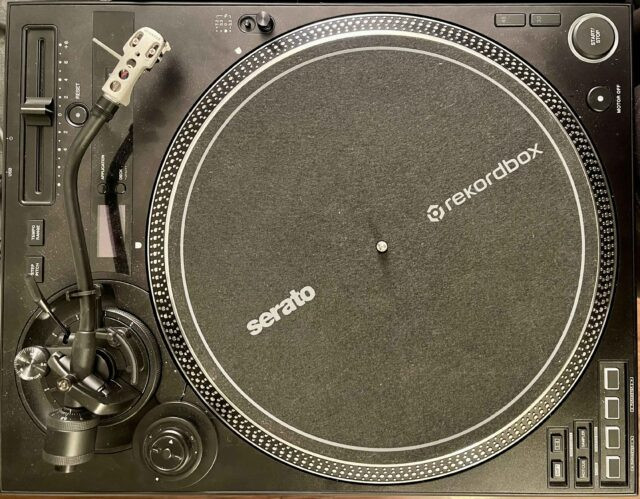 Pioneer PLX-CRSS12 turntable layout from above, showcasing tonearm and controls
Pioneer PLX-CRSS12 turntable layout from above, showcasing tonearm and controls
 Angle view of Pioneer PLX-CRSS12 controls and platter
Angle view of Pioneer PLX-CRSS12 controls and platter
For DJs accustomed to traditional turntables, the PLX-CRSS12 layout will feel immediately familiar. Standard components like the tonearm, pitch fader with ultra-pitch, and start/stop button are all positioned as expected.
The 33/45 RPM buttons are a subtle nod to battle-style setups, with the numbers printed in a reverse orientation for easy visibility in a performance setting. This thoughtful detail reflects Pioneer DJ’s understanding of the needs of turntablists and scratch DJs.
Performance Controls: Intuitively Integrated
The PLX-CRSS12 incorporates additional performance controls subtly and without disrupting the classic turntable aesthetic. Positioned on the lower left side in battle mode, these controls echo the layout of Novation Dicers, offering quick access to essential DJ software features.
Four primary buttons are assignable to Hot Cues, Stems, Sampler, and Scratch Bank. Page buttons allow cycling through two pages of functions, and a Shift button expands this further with access to two additional customizable pages.
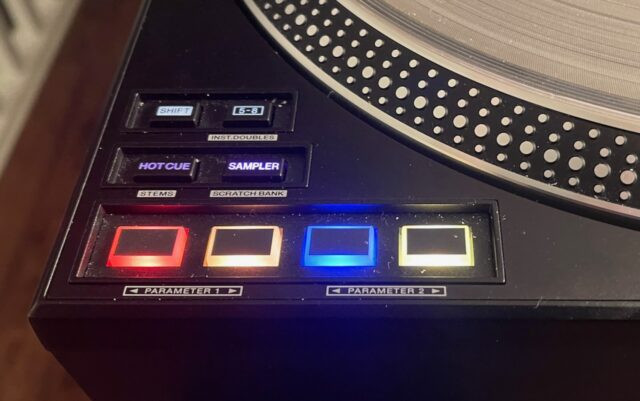 Close up of performance control buttons on Pioneer PLX-CRSS12 turntable
Close up of performance control buttons on Pioneer PLX-CRSS12 turntable
While some DJs might find these performance controls redundant, especially those using advanced DVS mixers like the DJM-S11, they provide valuable dedicated buttons for features like Stems and Scratch Bank. This reduces the need for constant page switching on the mixer and streamlines workflow.
Utility controls are located under the tonearm cradle, including buttons for switching between vinyl and timecode modes, deck selection, and software application (Serato/Rekordbox). While less immediately accessible, these settings are typically configured once, minimizing any inconvenience.
Holding the Deck button accesses the Utility screen for customizing torque (low, medium, high), LCD brightness, standby mode, and factory reset options.
Overall, the integrated controls are a welcome addition, though the buttons are somewhat compact. While the Reloop 8000 MK2 offers slightly more spacious controls, the PLX-CRSS12 strikes a good balance between functionality and a clean, traditional turntable design.
Step Pitch: A Creative Pitch Play Tool
Step Pitch is a novel feature enabling semitone pitch adjustments using the pitch fader, reminiscent of Reloop 8000 MK2’s Platter Play mode.
While its immediate utility might not be obvious to all DJs, Step Pitch offers creative potential for turntablists. However, it may not be as musically intuitive as pad-based pitch play found on the Reloop 8000 MK2, which allows for scale and root note adjustments for more melodic manipulation.
Build Quality: Robust and Premium
The PLX-CRSS12 is built upon a modified Hanpin Super OEM chassis, a platform known for its reliability and durability in DJ turntables for decades. While based on this established platform, Pioneer DJ has customized various aspects, from the housing to the motor, to meet their specific performance standards.
The build quality of the CRSS12 is undeniably premium, featuring a high-quality plastic casing and a robust metal top faceplate. Weighing in at approximately 27 lbs, it aligns with other Super OEM decks, conveying a solid and substantial feel.
While long-term durability requires extended use, the initial impression is of a meticulously engineered and manufactured piece of equipment, benefiting from Hanpin’s proven track record in turntable manufacturing.
Connectivity: Modern and Comprehensive
 Rear panel connectivity of Pioneer PLX-CRSS12 turntable showing ports
Rear panel connectivity of Pioneer PLX-CRSS12 turntable showing ports
Beyond standard RCA ports, Pioneer DJ retains a separate grounding cable, opting against internal grounding common in some modern turntables. The grounding is removable and replaceable, a practical improvement over older designs like Technics, which required disassembly for grounding wire replacement.
Pioneer DJ continues to champion USB-C as the modern USB standard for PC connectivity.
The timecode signal output is at phono level, ensuring seamless switching between timecode and vinyl without requiring mixer or interface adjustments.
Software Compatibility: Serato and Rekordbox Ready
The PLX-CRSS12 is compatible with both Serato and Rekordbox, supporting both timecode signal types. While Serato remains the dominant choice for DVS DJs, Rekordbox compatibility is a significant and welcome addition, especially considering earlier Pioneer DJ DVS products initially lacked Rekordbox support.
Standout Features We Loved
The Magvel Clamp: A Masterpiece of Design
 Close-up of the Magvel Clamp on the Pioneer PLX-CRSS12 turntable
Close-up of the Magvel Clamp on the Pioneer PLX-CRSS12 turntable
The Magvel Clamp is a truly brilliant innovation. Pioneer DJ has taken a core turntable component that has remained largely unchanged for decades and introduced a remarkable solution. It’s arguably the most elegant implementation of locking spindle technology to date. The freedom to use any record or slipmat without modifications is revolutionary, and the adjustable tension elevates the digital turntable control experience to a new level.
Furthermore, the Magvel Clamp doubles as a vinyl clamp, effectively flattening warped records with its adjustable tension.
Aesthetic Appeal: Classic Meets Modern
Pioneer DJ’s design choices can sometimes be polarizing, but with the PLX-CRSS12, they’ve achieved a perfect balance. It evokes the timeless aesthetic of the iconic Technics 1200 while incorporating modern elements for a sleek and enduring look. The added controls are discreet, and the minimal screen provides essential information without visual clutter.
Tactile Feel: Optimized for Performance
For scratch DJs and turntablists, the feel of the PLX-CRSS12 is exceptional. Super OEM decks are favored for their high torque, responsiveness, and ultra-pitch range. Pioneer DJ has fine-tuned the torque and feel of the CRSS12 based on feedback from leading scratch DJs.
The high torque setting emulates the revered Vestax PDX2000, known for its motor feel, while the medium setting mirrors the Technics 1200. The low torque setting, while available, might be less appealing to performance-focused DJs.
Serato Noisemap Timecode: Superior Tracking
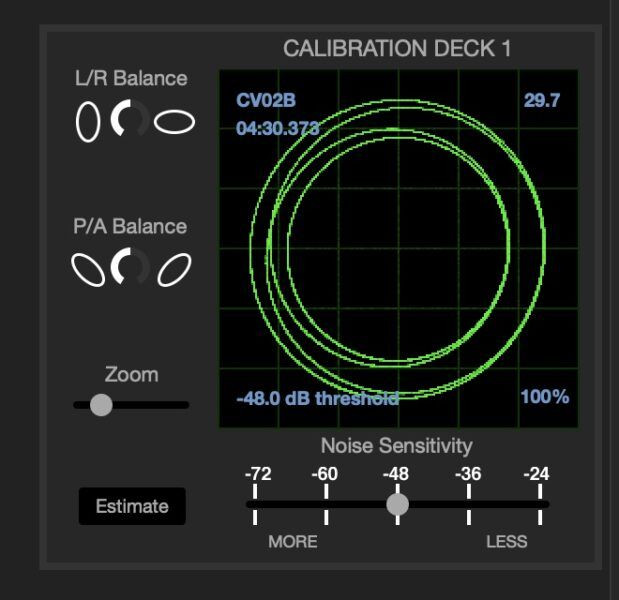 Serato Noisemap timecode vinyl graphic
Serato Noisemap timecode vinyl graphic
The PLX-CRSS12 utilizes the official Serato Noisemap timecode tone, incorporating a proprietary noise layer over the 1kHz sine wave. This technology, developed for Scratch Live, enhances tracking precision and enables software features like needle drop and sticker lock.
While not all Noisemap features are built-in, the superior tracking tightness is immediately noticeable. Users familiar with alternative timecode solutions will appreciate the reduced sticker drift and enhanced responsiveness.
Areas for Improvement
Lack of MIDI/HID Platter Control
While timecode offers tight scratching response, MIDI/HID platter control, as found on the REV7 or Rane Twelves, offers advantages like high-resolution control, instantaneous pitch adjustments, and advanced software integration features. Offering both MIDI and timecode options, similar to the Rane Twelve MK2, would enhance versatility.
Premium Price Point: $1,400 Per Deck
At $1,399 USD per deck, the PLX-CRSS12 is the most expensive DJ-focused turntable ever, surpassing even the Technics 1200 MK7. While its features are advanced, this price is significantly higher than standard turntables or even feature-rich models like the Reloop 8000 MK2. A pair of PLX-CRSS12s represents a substantial investment.
MIDI CC Conflicts in Serato
The second custom MIDI page on the PLX-CRSS12 shares MIDI CC assignments with the Scratch Bank controls on the DJM-S7, causing conflicts when mapping custom controls. This overlap is unexpected, especially given the PLX-CRSS12’s built-in Scratch Bank controls. While not tested with the DJM-S11, potential conflicts may exist there as well. No conflicts were observed with the Rane Seventy-Two mixer.
Limited Under-Deck Space
Compared to turntables like the Technics 1200 or Rane Twelve MK2, the PLX-CRSS12 offers less clearance under the deck. This can make cable management and laptop stand placement more challenging for DJs seeking a clean setup.
Proprietary Magvel Clamp: Potential for Scarcity
While innovative, the Magvel Clamp, like the REV7 platters, is a proprietary component. This raises concerns about potential parts scarcity and replacement delays, as seen with REV7 replacement platters. Losing or damaging a Magvel Clamp could necessitate sourcing a specific replacement part. However, Magvel Clamps are currently sold separately, mitigating some of these concerns, and in emergencies, Rane adaptors can be used as a temporary substitute.
Final Verdict: The Pinnacle of DJ Turntables
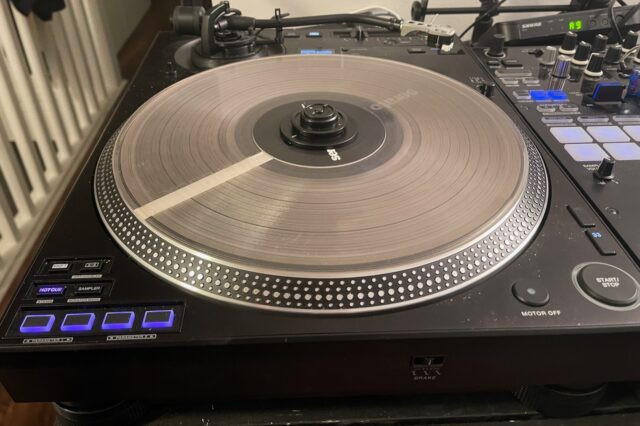 Pioneer PLX-CRSS12 turntable in a DJ setup
Pioneer PLX-CRSS12 turntable in a DJ setup
The Pioneer PLX-CRSS12 is arguably the finest turntable available for DJs today. Its design synergy is exceptional, seamlessly blending needleless DVS control with a fully functional turntable and the ingenious Magvel Clamp. It represents a potentially definitive turntable for discerning DJs.
While minor drawbacks exist, such as the lack of MIDI platter option and a few design quirks, these are minor compared to its overall excellence. The PLX-CRSS12 is a triumph for Pioneer DJ’s scratch/turntable/DVS division, solidifying their leadership in the market.
The Price Consideration
The primary caveat is the $1,400 price tag. $2,800 for a pair of turntables is a significant investment, especially as the core functionality isn’t entirely new. The innovation lies in the refined execution and convenience. While the Magvel Clamp is a remarkable achievement, alternatives like Phase offer similar needleless functionality at a lower cost when paired with other turntables. For example, a pair of Reloop 8000MK2s with Phase provides comparable features for approximately $700 less, potentially allowing budget for additional equipment.
Pioneer DJ has positioned the PLX-CRSS12 as a luxury item, and it undeniably is. It offers a premium DJing experience, much like a luxury car provides a more refined experience than a standard vehicle.
Who is the PLX-CRSS12 For?
The PLX-CRSS12 is clearly targeted at turntablists, hip-hop DJs, open format DJs, and DVS users who value vinyl integration.
While not essential for DJs already equipped with turntables and Phase, the PLX-CRSS12 is undeniably desirable. It’s a stunning deck that elevates any DJ setup with unmatched elegance and modernity.
For DJs who demand the best and most advanced turntable technology and whose budget allows, the Pioneer PLX-CRSS12 is the ultimate choice.
The Pioneer DJ PLX-CRSS12 Direct Drive Turntable is available now at the DJ TechTools store for $1,399. Is it worth the price? Share your thoughts in the comments below.
